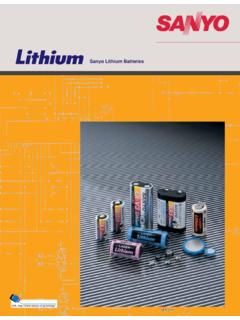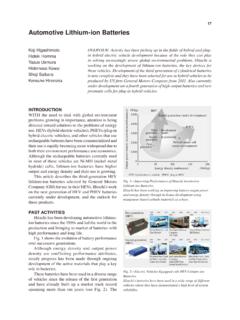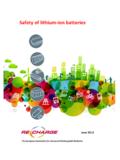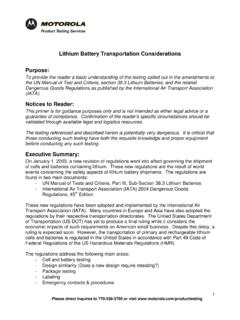Transcription of Lithium Technical Notice - Tadiran Batteries
1 NOVEMBER 2015 Page 1/3 LTN0111 See us on the web: Lithium Technical Notice Subject: Guidelines for Disposal of Lithium Cells and Batteries General The overall discharge reaction of the Tadiran Lithium /Thionyl Chloride cells is described by the following chemical equation: 2 SOCl2 + 4Li SO2 + S + 4 LiCl The Thionyl Chloride presents in fresh cells is subsequently converted into Lithium chloride during discharge. Some amounts of sulfur and sulfur dioxide are also formed. Generally, in fully discharged cells 90-95% of the Thionyl Chloride reacts in accordance with the above equation. When Lithium /Thionyl Chloride cells are disposed of in an open landfill, they will eventually discharge and may open by corrosion of the can. In this case the residual Thionyl Chloride will react with moisture to form sulfur dioxide and hydrogen chloride. SOCl2 + H2O SO2 + 2 HCl The remaining cell components include the carbon cathode, Lithium chloride, aluminum chloride, metallic can, cover and current collector.
2 Metallic Lithium is almost completely consumed in a fully discharged cell. There is no long lasting contamination as a result of disposal of Lithium /Thionyl Chloride cells. There are only hazards associated with the neutralization and disposal processes. Once neutralized, the end products of deactivated Batteries are not toxic. Tadiran Lithium /Thionyl Chloride cells do not contain malicious or hardly decomposable pollutants like heavy metals or organic solvents, which have lasting toxic environmental effects. The Batteries are free of mercury, lead, manganese, and cadmium. Instructions for Disposal for the disposal of Lithium Batteries are continually under review. Tadiran can becontacted if additional disposal guidance is required. Waste management companies canprovide assistance in the disposal of these cells and Disposal should be done in accordance with applicable regulations, which vary from countryto country.
3 In most countries trashing of used Batteries is forbidden and disposal can be donethrough non-profit organizations mandated by local authorities or organized by Cells and Batteries should not be incinerated, unless suitable procedures are followed andqualified handlers have taken appropriate precautions. Exposure of these cells to hightemperatures or fire can cause the cells to vent and/or rupture. May 2008 Page 2/3 LTN0111 See us on the web: 4. Used Batteries should be shipped with the same regulations as those for new Lithium / Thionyl Chloride Batteries . 5. Tadiran recommends that cells and Batteries for disposal should be collected, transported and disposed of in a manner that will prevent short-circuit (all leads should be cut-off and the terminals taped). 6. Handling of used cells and Batteries should be done according to the safety instructions of fresh cells. 7. Recycling of the cells and Batteries should be done in authorized facilities, through licensed waste carrier.
4 A recycler in US is listed below. Disposal in Europe The European Community (EC) has issued two directives; 91/157/EEC of 18/03/1991 and 93/86/EEC of 04/10/1993. Each member country implements these independently. Thus, in each country the manufacturers, importers and users are responsible for the proper disposal or recycling. In accordance with these directives the Tadiran Lithium Cells do not contain dangerous substances. The reaction products are inorganic and do not represent environmental hazards, once the decomposition or neutralization process has terminated. For Batteries bought from Tadiran Germany, in Europe, the company, upon customer request offers a disposal service. The following rules have to be considered: 1. The return has to be advised prior to shipment to the sales department of Tadiran Germany: Phone:+49(0)6042/954-122 Fax: +49(0)6042/954-190 2. Batteries have to be returned properly packed, if possible in the original package; minimum demand: protection against short circuit.
5 3. Shipment has to be free warehouse Tadiran . Key word on dispatch papers: "Disposal". Batteries for disposal should not be transported by air. For road transport of dangerous goods ADR special provision 636 and packing instruction 903a apply. See. Disposal in US Lithium Batteries are neither specifically listed nor exempted from the Federal Environmental Protection Agency (EPA) hazardous waste regulations, as conveyed by the Resources Conservation and Recovery Act (RCRA). The only metal of possible concern in the cell is the Lithium metal that is not listed or characterized as a toxic hazardous waste. Significant amount of spent cells and Batteries that are untreated and not fully discharged are considered as reactive hazardous waste. Thus, hazardous waste of spent cells and Batteries can be disposed after they are first neutralized through an approved secondary treatment prior to disposal (as required by Land Ban Page 3/3 LTN0111 See us on the web: Restriction of the Hazardous and Solid Waste Amendments of 1984).
6 Disposal of spent Batteries should be performed by authorized, professional disposal company, which has the knowledge in the requirements of the Federal, the State and the Local authorities regarding hazardous materials, transportation and waste disposal. In any case it is recommended to contact the local EPA office. PROPER SHIPPING NAME: Waste Lithium Batteries UN NUMBER: 3090 LABEL REQUIREMENTS: MISCELLANEOUS, HAZARDOUS WASTE DISPOSAL CODE: D003 Following is a suggestion for battery recycler and collector in the US: Retreiv Technologies 265 Quarry Road SELancaster, OH 43130 740-653-6290 CONFIDENTIALITY Notice . This document may contain confidential information. It is intended only for the recipient(s). If you are not the intended recipient, you are hereby notified that the disclosure, copying, distribution or use of the contents of this transmission is strictly prohibited, and no privilege or protection has been waived.
7









